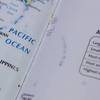Donjon: All Service, All in the Family
While there is a plethora of marine service companies, many of them family-owned, few can boast six family members actively involved in the business at the same time.
Donjon Marine Co., Inc. in Hillside, NJ, is one company to know if you haven't heard of them before. Led by J. Arnold Witte, Sr., Chief Executive Officer and President of the company he founded in 1967, Donjon is a multi-faceted marine service company that offers salvage and wreck removal, but through a controlled expansion, boasts a serious diving capability, marine engineering and heavy lift services, towing, dredging, barge chartering, demolition, and spill clean-up and pollution prevention services. Donjon also provides environmental solutions through its affiliated companies Clean Venture, Cycle Chem, and General Chemical.
Donjon itself is named after Arnold Witte's two oldest children, Donna and John. Donna no longer works for the company, leaving her career, at least temporarily, to become a full-time mother, while her younger sister, Tracey, has taken up the slack in the insurance department.
Executive Vice President John Witte, Jr., Arnold's oldest son, is often seen consulting with his father on company issues. Thomas, the third son, has grown the dredging businesses to the fourth largest in the U.S. James Witte has just taken over the management of Donjon Iron and Metal, Donjon's scrap processing facility located in Staten Island, NY. And Matthew Witte, the youngest of his six siblings, manages Donjon's software network.
The Donjon companies employ more than 400 full-time professionals, have a fleet of more than 40 wholly-owned and operated vessels including four salvage tugs, which range in horsepower from 1200 to 8000; a fleet of crew and utility vessels from 250 to 1200 hp; and three units of heavy lift Derrick barges with 200- to 1000-ton capacity. All are ABS loadlined and hold valid USCG Certificates of Inspection for ocean operations. Also included is a barge fleet of over 25 units ranging in size from 30 x 90 to 200 x 56 ft., along with in-house hydraulic submersible pumping systems from 2 to 18 in., diving equipment, welding machines, and hydraulic winch systems with pulling power of over 3000-ton capacity, as well as all related equipment to support its operations. Considered by many in the marine industry to be an icon, J. Arnold Witte, Sr. was recognized as such last year when he was inducted into the International Maritime Hall of Fame for lifetime contributions to the maritime community. A former president of the International Salvage Union (ISU) and a member of the ISU's Executive Committee, the U.S. National Research Council's Committee on Marine Salvage Issues, and the first president and a founding member of the American Salvage Association (the trade group for the professional salvage industry), all add to his impressive resume.
"I started as an admiralty lawyer in 1963, but left the practice - and my button-down shirts and suits - four years later to work full time at Donjon, a company I incorporated in 1964, after I saw the potential the marine industry held. Small salvage and wreck removal projects in New York Harbor and the surrounding areas offered a risk-reward opportunity that proved to be both exciting and productive," said Witte, Sr. "We started the company with just one small launch, a station wagon, and one additional employee, offering only salvage and wreck removal services," he said. My first salvage dive utilized a Sears Roebuck paint sprayer as a compressor and a garden hose coupled to a Desco soft mask. "Over the years we diversified our offerings to meet the demands of the shifting marine market while trying to build upon our original focus of emergency marine response and related activities," Witte, Sr. continued.
When Donjon was incorporated in 1967, the salvage industry and Donjon were very different than they are today. Industry communications were such that a telephone call to a London underwriter was rare. Everything was accomplished by exchange of telex and it seemed that negotiations and contracting went much quicker with little delay. The insurance industry, as well as the players in salvage, generally had personal knowledge of each other and relationships, rather than dollars and cents, had as much to do with contracting as the bottom-line dollars and cents. The wreck removal and salvage industry was based on the value of the hull and cargo and there was virtually no environmental impact on the contracting mechanism and the performance of the work.
According to John Witte, Jr., in an industry that is undergoing rapid change, the need for flexibility is vital. "The Valdez spill and the implementation of OPA '90 was the watershed event for the salvage industry," he said. Responsible for creating Donjon's OPA-90 program and the company's Regulatory Compliance Program relative to all marine salvage activities, Witte, Jr. continued, "To succeed in this business in today's environment you have to be able respond to any emergency by communicating, cooperating and utilizing all the facets of your company to make the job a success."
Mr. Witte, Sr. agrees. "Today, environmental consequences are paramount and contracting negotiations as well as the actual performance of work is often driven by economics, legal wrangling and regulatory influence rather than a most prompt and effective performance," he said. "Although this is the world we live in today, we need to work to resolve emergency solutions with time-saving cooperation among all of the interested parties," he noted. Donjon has completed hundreds of jobs over the years, but perhaps the most interesting wreck removal/salvage job was perhaps the removal of the Irving Whale from the Gulf of St. Lawrence in August 1996. It involved the lifting of a fully laden 5,000-ton oil barge from 250 feet of water in open ocean conditions. The effort was further compromised by the presence of dangerous PCB's leaking from the heating pipes and engine room. The removal of this wreck, under close environmental scrutiny by the Canadian Government, was accomplished with total success.
Always the optimist, J. Arnold Witte, Sr., sees a bright future for Donjon and the industry. "Despite the opinion of many that marine emergency response has no future, I believe that although the industry has changed, the impact of the environment, security risks, and the ever-increasing values attendant to any casualty will provide an economically sustainable salvage industry. What we need to do is recognize the value of emergency marine response and then build a framework to insure the economic viability of that standby response," he said. The implementation of the United States Coast Guard's new salvage regulations, long overdue, is a critical first step in the right direction. He reflects quietly for a moment. "We'll be ready no matter what," he says with a smile.











